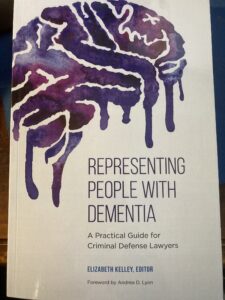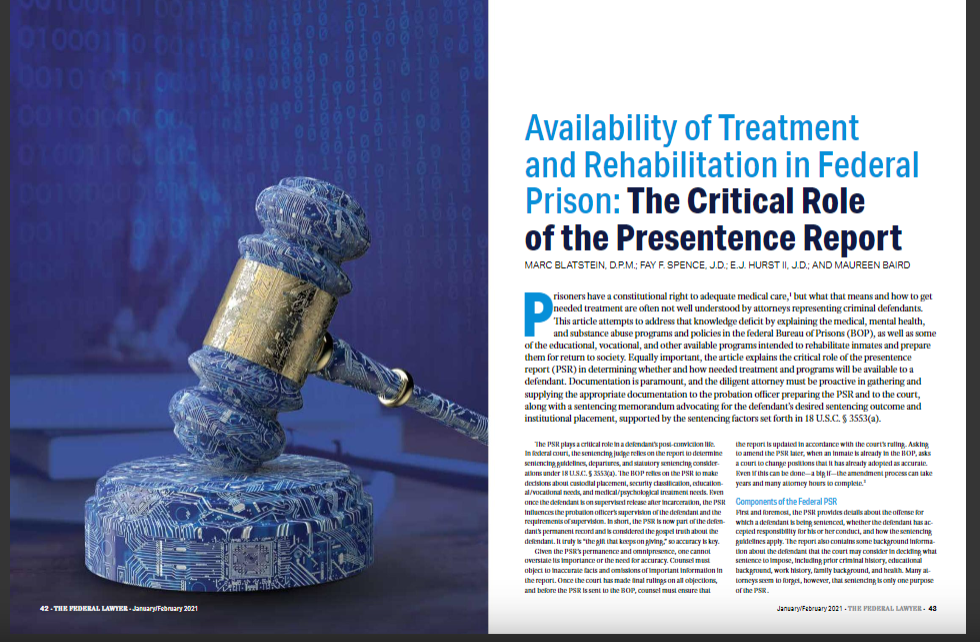First Step Act Programs (FSA)*
I) EARNED TIME CREDITS FIVE YEARS LATER (ETC)
II) FSA Needs Assessment Components (BOP.gov)
III) EBRR, Evidence-Based Recidivism Reduction
IV) PA, Productive Activities
V) The New Reality of The FSA
Be Prepared When Requesting To Answer Your SPARC-13 Assessment Survey,Survey Pdf Questions then, weaving your answers into your Reentry/Release Plan – before your Presentence Interview.
In this video, I discuss the steps to prepare for your Presentence Interview and explain that once you are incarcerated, it’s your responsibility to advocate for yourself through personal growth, self-learning, and taking advantage of all Fiest Step Act Programs – documenting your new knowledge along the way. Your lawyers will not be present to assist you. I delve deeper into this and provide further insights in this video.
STAKEHOLDERS are responsible for ensuring that your time in prison is uneventful and your criminal tendencies have been changed when released.
It is important to demonstrate that you have accepted responsibility for your crime and show remorse for the victim you have harmed, preferably before your presentence interview. However, it is better to do so later than never.
Once inside, stay out of trouble, take the assessment (Sparc-13), and then show up at each of the First Step Act Classes your case managers recommended without rolling your eyes. Why do I say this? See my video on how to implement the First Step Act successfully.
Your Case Manager recommends taking a First Step Act Class, like on Balancing your Checkbook (yes, really, and say thank you!!). Next, with all your free time, Education, Personal Development, and doing your job are all important. Staff doesn’t care, but they will know if you don’t do your job and if you are pursuing a possible career interest in History, Marketing, Science, or Biographies (anything), which can include painting, woodworking, or reading Non-Fiction books – great!
Can you prove that you’ve taken the FSA classes (if challenged) or have read these books? Suppose after 6 months at your meeting with your Case manager they let you know that you missed several classes – what is your response? If you don’t keep a paper trail, as in writing down everything that you do as proof for them and a future reference resource for you, you could have a serious problem. This case shows that the defendant thought he had 365 days worth of credits, and he went to court. As you can read, among his other issues, the BOP stated he had only 75 days.
I always needed to keep notes on content I felt I could use later (when I was taking exams). With all this documentation going into your Release Plan, you will continually watch it grow – which may contribute to an earlier release. Plus, as you are writing all of this into your Release Plan, keeping the originals for yourself, eventually, your Case Manager will take notice. Why? Because it is very possible no one else is doing this.
Colette Peters, the new Bureau of Prisons director, has created a lot of hope for change among staff, inmates, and Congress alike.
Attempting to make actual cultural changes and improvements to the conditions of care and custody in a behemoth industry (the BOP), at best, will not happen overnight. Still, Director Peters presents a pathway for optimism. Only time will tell.
COLLEGE EDUCATION GOOD NEWS:
1st) President Biden announced the 2nd Chance Pell Grant Program For Getting a College Education, which will be available starting 7/2023 and Now in The BOP. To get the full benefits from the program, please keep updated with the participating colleges and universities as they continue to enroll.
2nd) YALE PRISON EDUCATION INITIATIVE. Zelda Roland, Founding Director, YPEI. After working with students enrolled in Wesleyan’s Center for Prison Education at Cheshire Correctional Institution – Meet The Team. She coordinates with the Connecticut Department of Corrections and other national and statewide prison education programs and criminal justice organizations. “Prison Education Initiative brings liberal arts to incarcerated students.”
I) EARNED TIME CREDITS (ETC)
10/27/2023 Update: FIVE YEARS LATER, BOP STILL DOESN’T HAVE FIRST STEP ACT CREDITS that predict when a prisoner will leave BOP custody for halfway house or home confinement (HH/HC).
3/8/2023: The BOP is now in its third iteration of FSA calculation of your Earned Time Credits (ETC). According to a recent Forbes article, they have decided not to count the first assessment towards ETC, done within 30 days of arrival at the prison. Instead, 15 days/month can only be earned after the first year (or 3 assessments later) – on the BOP new time clock.
In addition to those incarcerated hoping to benefit from the FSA, this act has added the financial burden back to taxpayers and appears to conflict with the law’s intent as Congress intended squarely – so stay tuned and keep the faith!
Call 240.888.7778 for a personal one-on-one call
to discuss your current issue or that of a loved one.-Marc Blatstein
We are not Attorneys; you need Legal Representation.
* While the FSA programs were initially meant for those already incarcerated, there are specific ones with limited availability and are security-level specific. These are mental health oriented.
Proactively understanding the nuances of the FSA is complicated and, unfortunately, constantly ever-changing, but it can still prove worthwhile …
Referencing this, if done before the PSI, could demonstrate good faith on the part of your client to the court and significantly impact their future.
Call 240.888.7778 for a personal one-on-one call
to discuss your current issue or that of a loved one.-Marc Blatstein
PATTERN SCORING: Men, Women; then Violent Additional Score Points
This video reviews the Alternative Benefits of Pattern Scoring.
II) FSA Needs Assessment Components (BOP.gov):
- Anger | Hostility Temperamental and antisocial personality, including anger and hostility.
- Antisocial Peers Associating primarily with peers involved in criminal behavior puts one at a higher risk of sharing in that behavior. Over time, incarcerated individuals lose contact with their prosocial support system, leaving them without a network to help reinforce appropriate behaviors. To Reduce association with antisocial peers and enhance contact with prosocial support.
- Cognitions are assessed by the Measures of Criminal Attitudes and Associates (MCAA; Mills & Kroner, 2001) assessment. The MCAA is used to assess the needs of Antisocial Peers and Cognition.
- Dyslexia needs must be assessed with measures that meet certain specifications outlined in the FSA. The BOP instituted a two-phase screening process. First, all inmates complete a screening instrument that examines symptoms across functional domains. Inmates who reach the threshold are then administered the Woodcock-Johnson IV, a reliable and psychometrically robust test capable of a formal diagnosis.
- Education The Education Need is assessed by the presence or absence of a high school diploma or its equivalent. The Test of Adult Base Education (TABE) and the Comprehensive Adult Student Assessments (CASAS) are used to assess the literacy level.
- FAMILY/PARENTING Research has found links between family environment and criminal lifestyle.
- FINANCE/POVERTY There is a direct correlation between poverty and criminality.
- MEDICAL is assessed through a history drawn from PSI (which in turn comes from the PSR) documents and an in-person interview and physical performed by a medical practitioner at a BOP institution.
- MENTAL HEALTH Psychology Services Inmate Questionnaire (PSIQ)

- If your client is approaching Dementia or is currently being treated,
- Fay Spence and I are proud to have contributed two chapters to REPRESENTING PEOPLE WITH DEMENTIA, Published, ABA.
- What Is Dementia? Page 1, Dr. Marc Blatstein, and Faye Spence, Esq.
- Jail and Prison Conditions, Page 155, Dr. Marc Blatstein, and Faye Spence, Esq.
- There is only 1 BOP location,
- with 1 wing; if I recall what I read last,
- they have only a limited number of beds.
- Fay Spence and I are proud to have contributed two chapters to REPRESENTING PEOPLE WITH DEMENTIA, Published, ABA.
- If your client is either Autistic or has a Borderline Personality Disorder,
- both under current treatment with
- appropriate diagnosis coding for each
- The BOP has only 2 facility locations,
- If that is not limiting enough, they are security-level-specific.
- If your client is a young male, approximately 32 years old, facing their first federal sentence, the BRAVE Program is designed
- for young males (Admission Criteria).
- Predicted to serve at a BOP USP Medium Institution,
- facing 60 months.
- The program’s goal is to facilitate favorable adjustment and
- reduce incidents of misconduct.
- If your client is approaching Dementia or is currently being treated,
- RECREATION/LEISURE/FITNESS
- SUBSTANCE USE associated with criminality.
- TRAUMA is assessed using the Adverse Childhood Experiences Scale.
- WORK [vocational training and job readiness programs, for example, 2019 FCI Englewood Computer-Aided Design (CAD)]
III) EBRR, Evidence-Based Recidivism Reduction
- Anger Management Anger Management is a cognitive-behavioral curriculum designed to help individuals better manage their anger.
- Apprenticeship Training Apprenticeship training prepares the student for employment in various trades through structured programs underneath a journeyman in that trade, approved at the state and national levels by the Bureau of Apprenticeship and Training, U.S. Department of Labor.
- Assert Yourself for Female Offenders In this program, women learn to be assertive while respecting the boundaries of others.
- BARTON READING AND SPELLING SYSTEM It was designed with adults in mind because it is never too late to significantly
- Basic Cognitive Skills participants are taught basic concepts of cognitive-behavioral therapy, including the Five Rules for Rational Thinking and the use of Rational Self-Analysis (RSA).
- BE- ACTIV is a psychosocial treatment program for depression in aging adults residing in nursing care center settings.
- BUREAU LITERACY PROGRAM The literacy curricula consist of an Adult Basic Education To Pass The General Educational Development (GED) Exam.
- BRAVE Program**, Bureau Rehabilitation and Value Enhancement Program– a cognitive-behavioral, residential psychology counseling treatment program for young males serving 1st sentence to create a smoother adjustment to prison. Medium Security, 32 years or younger with a sentence of 60 years or more.
- Certification Course Training This program falls under three broad categories: 1) Apprenticeship Training, 2) Certification Course Training, and 3) Vocational Training.
- Challenge** – a program for male inmates in Penitentiary (High Security) facilities. Treats those with substance abuse and/or mental illness disorders (psychotic, mood, anxiety, or personality).
- COGNITIVE BEHAVIORAL THERAPY FOR CHRONIC PAIN Through the 10 skills-based therapy sessions, individuals will begin to develop the skills necessary to gain a sense of control over their chronic pain.
- COGNITIVE BEHAVIORAL THERAPY FOR LATE-LIFE DEPRESSION for aging adults with depression or depressive symptoms. This program may be completed in an individual or group setting.
- Cognitive Processing Therapy Cognitive Processing Therapy is an evidence-based intervention for treating Posttraumatic Stress Disorder.
- Criminal Thinking The purpose of the Criminal Thinking program is to help the participants see how their past decisions have negatively impacted their lives.
- Dialectical Behavior Therapy for individuals who engage in self-directed violence, such as self-cutting, suicidal thoughts, urges, and suicide attempts.
- Emotional Self-Regulation Emotional Self-Regulation helps participants explore the emotions and patterns of behavior and learn strategies for managing difficult emotions.
- ENGLISH-AS-A-SECOND LANGUAGE** is an English language education study program for non-native speakers.
- FAITH-BASED CONFLICT MANAGEMENT (FBCM) PROGRAM students will strengthen their anger management skills, interpersonal communication skills, and conflict resolution techniques using practical spiritual principles and practices.
- FAMILY PROGRAMMING SERIES The program is designed to support participants in strengthening family relationships during incarceration and after release. The program consists of a Women’s Family Program Series and a Men’s Family Program Series designed to address the unique challenges faced by offenders and families during incarceration.
- Federal Prison Industries, FPI (UNICOR) – preparing for successful reentry through job training.
- Visit UNICOR / BOP.gov.
- Female Integrated Treatment (FIT) Program ** For female inmates with substance use, trauma (PTSD), and other mental illnesses. For those eligible for RDAP, this program is now available onsite, so there is no need for an extra needless transfer.
- Foundation Program For women 1st entering the BOP, helping them consider programs and services to ensure positive changes during their stay. The Change Plan (PA) works on the goals established by the Foundation.
- FUNCTIONAL ADAPTATION SKILLS TRAINING (FAST) FAST aims to improve independence and quality of life by targeting six areas of everyday functioning, which include: medication management, social and communication skills, organization and planning, transportation, and financial management.
- HOOKED ON PHONICS Note: Hooked on Phonics is not the Bureau-designated EBRR program for dyslexia; rather, The Barton Reading and Spelling System is to be implemented for students who have been identified with characteristics of the condition of dyslexia.
- Illness Management and Recovery IMR is considered a front-line intervention for treating serious mental illness.
- Life Connections Program (LCP) – a residential faith-based program, not religion-specific.
- Mental Health Step Down Program ** This residential program offers intermediate care for inmates with serious mental illness who do not require inpatient treatment but lack the skills to function in the general population.
- Money Smart for Adults: An instructor-led course that covers basic financial topics.
- Money Smart for Older Adults Provides awareness among older adults on preventing elder financial exploitation and encourages advanced planning as you age.
- The National Parenting From Prison Program Is a two-phase model focusing on services for incarcerated parents. Phase I focuses on parenting basics. Phase II focuses on specific parenting needs, such as parenting an incarcerated mother, father, or grandparent or parenting a child with a disability.
- Non-Residential Drug Abuse Program – a program requirement for supervised release or through judicial recommendation where there is a substance abuse offense.
- Post Secondary Education Program College-level classes are provided by credentialed instructors from the community who deliver coursework leading to either the Associate’s or Bachelor’s degree.
- Residential Drug Abuse Program, RDAP ** – an intensive treatment program where offenders experience living in a pro-social community. Available in Spanish. 2018 Current RDAP Locations.
- Resolve Program – a program for those with a Mental Health diagnosis related to trauma and designed to decrease the incidence of trauma-related psychological disorders – to improve a person’s (male or female) level of functioning.
- RESOURCE TOOLS FOR REENTRY FOR TRANSGENDER INDIVIDUALS The program is designed to help prepare transgender participants for the challenges of reintegrating into society in the topics of ID documentation, housing, employment, healthcare, and mental health.
- Seeking Safety (Female) and Seeking Strength (Male) This intervention teaches inmates to manage and decrease symptoms and gain control over both disorders by addressing current life problems.
- Sex Offender Treatment Program, Residential (SOTP-R), is a program for high-risk sex offenders, available during the last 36 months of their sentence, who have a history of multiple sex crimes, excessive non-sexual criminal history, and a high level of sexual deviancy or hyper-sexuality.
- Sex Offender Treatment Program Non-Residential (SOTP-NR) has a history of a single sexual offense, and many may be first-time offenders serving a sentence for an Internet-based sexual crime.
- SEXUALLY DANGEROUS PERSONS[i], Although the courts and The Designation and Sentence Computation Center (DSCC) identify inmates who may qualify to be certified as sexually dangerous, FCC Butner no longer houses these persons.
- FCC Butner Psychology Doctoral Internship Program[iii]is facilitated through The Psychology Services Department at Federal Correctional Complex (FCC) in Butner, North Carolina.
- In 2023, FCC Butner added two Forensic Postdoctoral Fellowships into the Federal Medical Center and Commitment and Treatment Programs.
- Skills Program: A program for inmates with intellectual disabilities, neurological deficits, and social deficiencies (i.e., Autistic). Participation can be at the beginning of their incarceration but is available at any time and can be ongoing.
- Social Skills Training Although designed for individuals suffering from schizophrenia, this resource is appropriate for any inmate with moderate social skills deficits.
- STAGES Program, Residential **A residential Psychology Treatment Program for inmates diagnosed with Borderline Personality Disorder.
- STRONGER TOGETHER, EMERGING PROUD (S.T.E.P.)The program is designed to provide a safe, supportive place for participants to discuss shared experiences as a transgender person, build their resilience, and create a support system.
- Threshold Program The Threshold Program is a non-residential faith-based reentry program, like the more intensive Life Connections Program; it is open to inmates across the BOP regardless of religious affiliation.
- TRANSITION ACCEPTANCE The program is designed to provide a supportive place for participants to explore the journey they’re on with their gender transition.
- Vocational Training This program combines three broad categories: 1) Apprenticeship Training, 2) Certification Course Training, and 3) Vocational Training.
- WAYSAFE The goal of this program is to improve decision-making skills so participants can avoid at-risk behaviors regarding HIV and other viral illnesses spread by sex or blood contact.
- WELLNESS INSIDE AND OUT The Wellness: Inside and Out program will target individuals who bring both physical and mental health problems to prison by offering skill-building lessons and specific goals.
- Women’s Basic Financial Literacy Program This program targets the financial deficits incarcerated women face as they prepare to reenter society.
- Woman’s Career Exploration Series Teaches strategies to help women succeed in the workplace and offers insights to assist women to overcome employment barriers and move toward long-term career success.
- WOMEN’S CAREER SKILLS** is designed to assist participants learn, develop and practice advanced skills for a fruitful career. This includes Communication, Planning, Connecting with Others, and Personal Growth.
- WOMEN’S LIFE SKILLS is designed to assist participants with life skill deficits to develop and practice skills for success in their basic daily habits and routines.
- WOMEN’S SEXUAL SAFETY The program includes three components: Sexual Health, Sexual Safety, and Healthy Sexual Relationships.
**RESIDENTIAL (MODIFIED THERAPEUTIC COMMUNITY)
IV) PA, Productive Activities
- A Healthier Me helps incarcerated women build healthy lifestyles
- A Matter of Balance decreasing fall-related fears
- AARP Foundation Finances 50+ provides financial education and counseling
- Academic Success: training in motivation and goal setting
- Access is designed for incarcerated women survivors of domestic violence.
- Alcoholics Anonymous (AA) Support Group reduces the likelihood of problematic drinking behaviors.
- Aleph Institute Correspondence Course program offers a wide array of learner-friendly materials, from a Hebrew Reading and Writing Course to the mystical teachings of the Kabbalah.
- Arthritis Foundation Walk with Ease is a six-week program that teaches participants how to safely make physical activity part of everyday life.
- Bereavement Support Group for individuals experiencing grief.
- Beyond Violence: Prevention Program for Criminal-Justice Involved Women assists women in understanding trauma and the aspects of anger.
- Brain Health as You Age: You Can Make A Difference! Improve memory and decision-making brain health and its impact on memory, judgment, decision-making, and overall physical health,
- Brief CBT for Suicidal Individuals developed for individuals at risk of suicide.
- CBT for Eating Disorders focuses on behavioral monitoring, body image concerns, and developing new skills.
- CBT for Insomnia helps to identify maladaptive thoughts and behaviors that can lead to persistent insomnia.
- CBT for Prison Gambling helps individuals assess their prison gambling behavior and develop the commitment to quit.
- Change Plan focuses on the goal established by the Foundation; participants identified three positive changes they wanted to make during incarceration.
- Circle of Strength is designed specifically for women in Federal Detention Centers or other short-term settings encouraging social support.
- Complicated Grief Treatment addresses individuals who are “stuck” adapting to loss.
- Dyslexia, a learning disorder most commonly caused by difficulty in phonological processing, is the number one cause of illiteracy.
- Disabilities Education Program (DEP) is designed specifically for inmates with physical disabilities in institutions of varying security levels and focuses on reentry concerns.
- Drug Education encourages participants with a history of drug use to consider the consequences of their drug use.
- Embracing Interfaith Cooperation, this program aims to provide an effective strategy for countering religious discrimination and extremism.
- FAITH-BASED CONFLICT MANAGEMENT (FBCM) PROGRAM: Through active participation in the 10 sessions, students will strengthen their anger management skills, interpersonal communication skills, and conflict resolution techniques using practical spiritual principles and practices.
- FAMILY PROGRAMMING SERIES: The program is designed to support participants in strengthening family relationships during incarceration and after release
- Federal Prison Industries (FPI) Lean Basic Training
- Franklin Covey’s 7 Habits on the Inside addresses interpersonal skills impacting relationships.
- Getting to Know Your Healthy Aging Body discusses changes in organs, physique, and other physiological processes as we age.
- Health and Wellness Throughout the LifespanThis program addresses the psychological effects of stress and aging.
- Healthy Mind and Bodies enhance their overall health and emotional well-being.
- Healthy Steps for Older Adults The program aims to prevent falls, promote health, and ensure that older adults remain independent.
- Hooked on Phonics a program that aids in combating Dyslexia as well as low-level readers – includes a high percentage of familiar patterns that give the student the opportunity to read for meaning.
- Houses of Healing: A Prisoner’s Guide to Inner Power and Freedom teaches emotional literacy skills and the ability to perceive, understand, and communicate emotions with self and others.
- K2 Awareness Program educates them about the risks of drug use and motivates them to seek drug treatment.
- Living a Healthy Life with Chronic Conditions 2022 is designed for older adults impacted by chronic conditions.
- Managing Your Diabetes, manage their chronic disease.
- Mindfulness-Based Cognitive Therapy is a group intervention aimed at preventing relapse in individuals with a history of depression and anxiety.
- Narcotics Anonymous reduces the likelihood of future drug use.
- National Diabetes Prevention Program is a program to assist at-risk and older adults in living healthier lifestyles and increasing physical activity.
- New (Create) Beginnings (CNB), is an art program that empowers incarcerated women to acknowledge and process their emotions as well as develop their self-awareness through artistic expression.
- PEER, Personal Education & Enrichment Resources support group is designed for inmates living with cognitive and physical disabilities while in institutions of varying security levels.
- Pu’a Foundation Reentry Program is a trauma-informed care program for female inmates at FDC Honolulu grounded in Hawaiian culture.
- Reach Out, Stay Strong, Essentials for Mothers of Newborns (ROSE), to reduce postpartum depression
- Resilience Support [VETERANS] provides resilience-building skills to veteran inmates of all uniformed services, encouraging peer and social support, emphasizing positive interpersonal relationships, physical and mental wellness, the discovery of life purpose and meaning, self-compassion, and personal growth.
- RESOURCE TOOLS FOR REENTRY FOR TRANSGENDER INDIVIDUALS: The program is designed to help prepare transgender participants for the challenges of reintegrating into society in the topics of ID documentation, housing, employment, healthcare, and mental health.
- Service Fit [VETERANS] supports a healthy lifestyle while encouraging social and peer support among participants.
- Sexual Self-Regulation (SSR) self-management skills to gain effective control over deviant sexual urges and behaviors.
- Soldier On [VETERANS], for veterans living in varying security levels.
- Square One: Essentials for Women is a basic life skills program for female offenders who meet the needs of lower-functioning women or those who have not lived or worked independently.
- START NOW, to treat offenders with behavioral disorders and associated behavioral problems, includes a gender-responsive program developed specifically for female offenders.
- STRONGER TOGETHER, EMERGING PROUD (S.T.E.P.), The program is designed to provide a safe, supportive place for participants to discuss shared experiences as a transgender person, build their resilience, and create a support system.
- Supported Employment is designed to match seriously mentally ill (SMI) individuals with competitive job opportunities suitable to their interests and abilities.
- Talking with Your Doctor: Guide for Older Adults on preparing for a medical appointment, discussing health concerns, and identifying appropriate assisted living…
- The Barton Reading and Spelling System was designed with adults in mind because it is never too late to significantly improve the reading, spelling, and writing skills of individuals with dyslexia.
- TRANSITION ACCEPTANCE: The program is designed to provide a supportive place for participants to explore the journey they’re on with their gender transition
- Trauma Education, Trauma in Life (for females), and Traumatic Stress and Resilience (for males) – designed to be educational
- THRESHOLD PROGRAM, Faith-based, focused on values and life skills: The curriculum is designed for individuals under 24 months, for participants who desire to participate from a non-religious perspective.
- Ultra Key 6: The Ultimate Keyboarding Tutor, proper typing technique
- Understanding Your Feelings: Shame and Low Self-Esteem helps women evaluate the role of shame and low self-esteem in their lives.
- Veterans Career Exploration helps identify skills for pursuing, applying for, and being successful in a long-term civilian career.
- Victim Impact: Listen and Learn, A rehabilitative program that puts “victims first.”
- Voices of Consequences Enrichment Series: Unlocking the Prison Doors (All Female): this program is designed to assist incarcerated women with identifying the need for healing and restoration in their lives. Participants explore the effects their negative choices have had on their lives while learning to identify and implement appropriate coping skills to assist them in making positive choices.
- Wellness Recovery Action Plan teaches individuals with serious mental illnesses to maintain their recovery through wellness activities.
- Women in the 21st Century Workplace addresses the workforce and soft skills of women with longer sentences.
- Women’s Aging: Aging Well, for incarcerated women ages 45 and up, finding and purpose, physical health, mental and emotional well-being, healthy relationships, and future planning
- WOMEN’S CAREER EXPLORATION SERIES (Female), strategies to help in the workplace. Components include identifying career paths that align with individual interests, building a professional network, applying for and gaining a job that leads to a career, establishing good work habits, and learning skills for thriving in the workplace.
- WOMEN’S BASIC FINANCIAL LITERACY PROGRAM (Female), This program targets – using a checking account, methods for beginning to save for the future, understanding credit and loans, creating a budget, accessing financial resources, understanding the purpose and use of insurance, and gaining financial independence.
- Women’s Relationships, developing healthy, prosocial relationships with friends, family, and acquaintances.
- Women’s Relationships II, This seven-part gender-responsive and trauma-informed series for women examines the relationships of incarcerated women.
- Women’s Reflections Group targets women who are struggling to make good choices in a safe and comfortable place where they can process problems and emotional concerns they are experiencing and gain the tools needed to work toward solving these problems.
- Your Guide to Labor and Birth is a comprehensive pregnancy education program completed during pregnancy.
V) The New Reality of the FSA
If your client is counting on the FSA Programs to expedite their release. In some prisons, they may find themselves successful, while in others, challenges still exist.
- While the risk assessment test is available,
- the BOP states that prisoners can only earn 10 credits per month for the first year of incarceration – as no assessment is provided at the first meeting.
- The programs they need are either not taking in new inmates due to overcrowding, or they’re just closed due to a lack of staff, and they now find themselves stuck in a system not knowing why, without any direction.
Still, the BOP will eventually retroactively provide the time-off relief that so many seek. Unfortunately, life in prison, possibly like the military, requires becoming comfortable – with being – uncomfortable.
If You Suspect You’re The Target of a Federal Investigation | Before The Presentence Interview (PSI) | After The PSI – But Before The Sentencing Hearing | After Sentencing or You’re Already Incarcerated | There Are Still Things We Can Do
Note:
For additional information on these programs, contact the Reentry Services Division (RSD) by emailing BOP-RSD-NRB-FSA@BOP.GOV. Sarah Qureshi, Office of General Counsel, Bureau of Prisons, phone (202) 353-8248.
Parts of the First Step Act (as of 10/2023) may not yet be 100% up and running uniformly across all BOP (and contracted) facilities since its 2018 creation.









